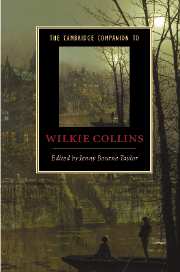Book contents
- Frontmatter
- Introduction
- 1 Collins’s career and the visual arts
- 2 The early writing
- 3 Collins’s shorter fiction
- 4 Collins and the sensation novel
- 5 The Moonstone, detective fiction and forensic science
- 6 The later novels
- 7 The professional writer and the literary marketplace
- 8 The marriage plot and its alternatives
- 9 Collins and Victorian masculinity
- 10 Collins and empire
- 11 Disability and difference
- 12 Collins and the theatre
- 13 The afterlife of Wilkie Collins
- Further reading
- Index
- Series List
11 - Disability and difference
Published online by Cambridge University Press: 28 January 2007
- Frontmatter
- Introduction
- 1 Collins’s career and the visual arts
- 2 The early writing
- 3 Collins’s shorter fiction
- 4 Collins and the sensation novel
- 5 The Moonstone, detective fiction and forensic science
- 6 The later novels
- 7 The professional writer and the literary marketplace
- 8 The marriage plot and its alternatives
- 9 Collins and Victorian masculinity
- 10 Collins and empire
- 11 Disability and difference
- 12 Collins and the theatre
- 13 The afterlife of Wilkie Collins
- Further reading
- Index
- Series List
Summary
Writing in Henry Mayhew's encyclopaedic London Labour and the London Poor (1861-2), Andrew Halliday gives a vivid impression of the numerous types of physical disability which could be encountered on the capital's streets in the mid-century. Although the Mendicity Society had recently cleared the streets of many imposters, a number of beggars continued to use their bodies as a source of income, and, in the spirit of this work's incessant drive to impose order on the disorderly, Halliday proceeds to list them:
The bodily afflicted beggars of London exhibit seven varieties. 1. Those having real or pretended sores . . . 2. Having swollen legs. 3. Being crippled, deformed, maimed, or paralyzed [some of these fall into the further category of 'Disaster Beggars'] 4. Being blind. 5. Being subject to fits [and hoping, for the most part, to be offered brandy to revive them]. 6. Being in a decline. 7. 'Shallow Coves', or those who exhibit themselves in the streets, half-clad, especially in cold weather.
When their conditions are genuine, Halliday considers these individuals as 'certainly deserving of sympathy and aid; for they are utterly incapacitated from any kind of labour'. Those who exhibit their deformed, maimed or impaired bodies simultaneously provoke revulsion and compassion, and seem to inhabit a quite different sphere from those who encounter them in the street.
- Type
- Chapter
- Information
- The Cambridge Companion to Wilkie Collins , pp. 153 - 167Publisher: Cambridge University PressPrint publication year: 2006
- 6
- Cited by



